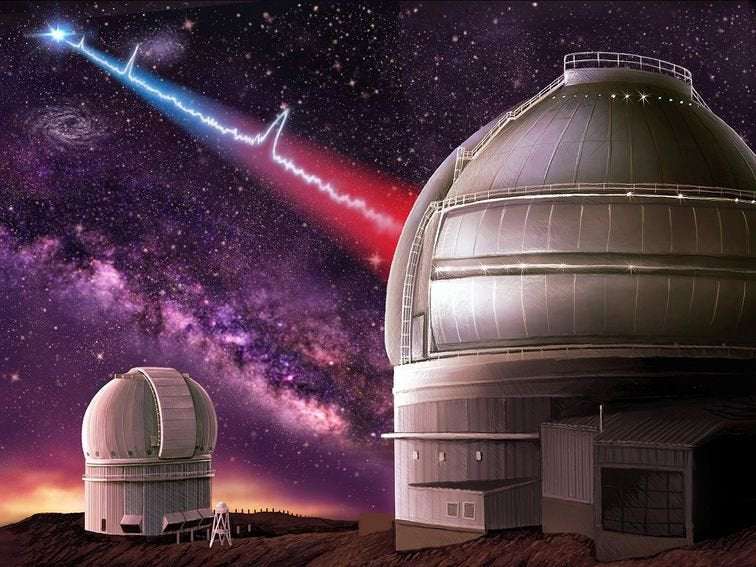In June this year, astronomers found a fast radio burst (FRB), FRB 121102, repeating in a regular pattern, from somewhere in deep space. It was only the second time a radio burst with a discernible, repeating pattern was discovered. The first was discovered back in February this year.
FRBs are transient radio pulses that vary in length between a fraction of a millisecond and a few milliseconds. We're still not sure why they exist or what they are. The source of this particular FRB is a dwarf galaxy more than 3 billion light years away.
Back in June a study, published in the journal Monthly Notices of the Royal Astronomical Society, theorized FRB 121102 repeated every 157 days based on data they'd accumulated over a five-year period. The team predicted they'd pick up another signal in July or August of this year.
And they did: Right on cue, FRB 121102 kicked off.
A new preprint study has confirmed that FRB 121102 has started up again, and this study confirmed a similar periodicity: 161±5 days. The new data confirms earlier theories FRB 121102 is sending a repeating radio burst; second, it allows scientists to predict its activity and study it more effectively, potentially learning more about its origins.
Could it be aliens? Probably not.
"I think in all likelihood we'll work out a natural explanation for these events, but I like to keep an open mind and follow wherever the evidence leads me," said Adam Deller, an astrophysicist at Swinburne University of Technology.
University of Manchester's Kaustubh Rajwade, who led research in the first study that identified the repeating FRB, thinks it could be a neutron star.
"Based on the short durations and the high luminosities of the bursts themselves, a good guess would be a neutron star with a very high magnetic field that is orbiting a companion object," he said.

Andromeda321 on August 25th, 2020 at 19:47 UTC »
Radio astronomer here! Probably too late to the party, but for the record I do not know any astronomers who think this signal is alien in origin. (Well, maybe Avi Loeb.) Instead, this is a very well studied type of signal by now, called a Fast Radio Burst. The interesting thing about them is they originate from well outside our galaxy, last a millisecond, and are one of the brightest things in the radio sky for that moment they are on. Until more recently there were no patterns in the signal anyone could really distinguish, and most FRBs appeared to be one offs (still true- people still argue whether they're just the brightest ones we are able to detect from one source repeating, or if there are two classes of signals).
Of all the FRBs out there, FRB 121102 is the best studied one because it's the first "repeater" ever found, discovered by Arecibo. People studied it for years but no pattern was obvious. However, as radio telescopes are really competitive for telescope time you couldn't exactly dedicate one to just staring at this thing a long time to figure out the larger patterns (the smaller bursts appear somewhat random), so it's not surprising to me a 5 month repetition took so long to sort out (particularly as you can see bursts in between).
As for what's causing it, we think FRBs are related to magnetars- perhaps very young one- which are basically neutron stars with such high magnetic fields that going within a thousand miles of one would kill you as the magnetic field stripped the electrons from the atoms in your body. Yes, they are cool! :D As for the period, it best makes sense if the magnetar is orbiting something else, and thus its orientation regularly changes with respect to Earth. Remember, most stars in space are in binaries, so it's not that weird to think a crazy magnetar like this (which would have been created during the death of a star) would be the same.
Finally, we don't think it's aliens because we see FRBs from all over the sky at all sorts of vast distances. If they kept sending one repeating signal from one patch of sky, sure, but all over the universe? It's most likely a natural process- sorry! However, I would argue that "gigantic radio bursts visible across half the universe from the corpse of a star squished so small it's the size of a city and so magnetic it would kill you, and no one predicted this" is pretty amazing too. :D
MrJusticle on August 25th, 2020 at 18:29 UTC »
"Based on the short durations and the high luminosities of the bursts themselves, a good guess would be a neutron star with a very high magnetic field that is orbiting a companion object," he said.
mottlymonical on August 25th, 2020 at 18:22 UTC »
Everyone chatting about first contact and how we'd cope. When actually first contact isn't going to be aliens visiting earth, but rather earth and another planet chatting over string cups late at night when their parents have gone to bed.